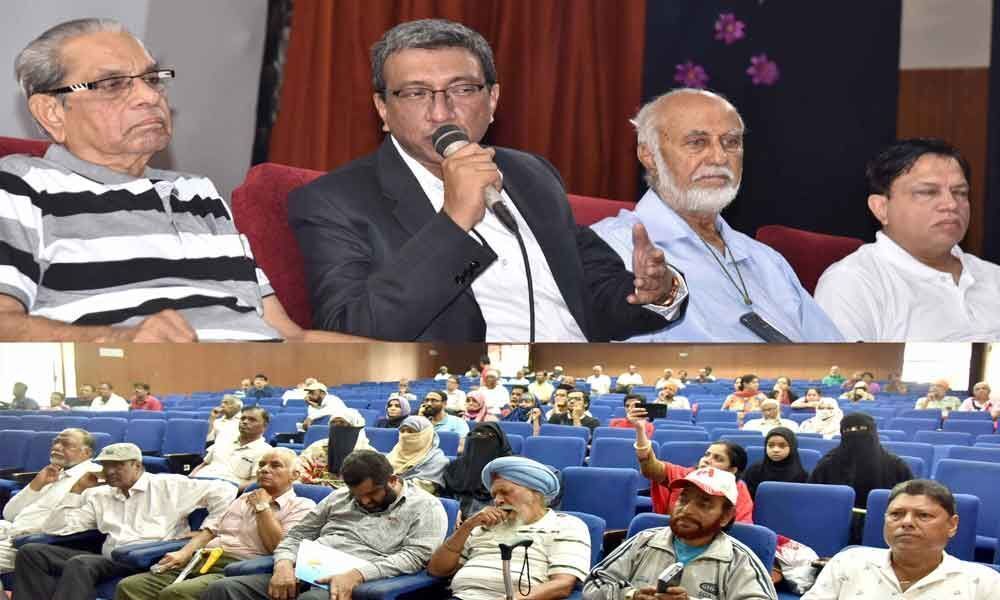Live
- They always want me to win, and now I feel lucky to have been offered a story like ‘Zebra’: Satyadev Kancharana
- ‘Democracy first, humanity first’: PM Modi in Guyana's parliament on two countries' similarities
- PKL Season 11: Telugu Titans register third straight win to top standings
- Is Pollution Contributing to Your COPD?
- NASA Unveils Underwater Robots for Exploring Jupiter's Moons
- Additional Central forces arrive in violence-hit Manipur
- AR Rahman and Saira Banu’s Divorce: Legal Insights into Common Issues in Bollywood Marriages
- 82.7 pc work completed in HPCL Rajasthan Refinery area: official
- Curfew relaxation extended in 5 Manipur districts on Friday
- Tab scam prompts Bengal govt to adopt caution over fund disbursement
Just In

In India, glaucoma is one of the leading causes of irreversible blindness with at least 12 lakh people being affected by it. More than 90% of cases of glaucoma remain undiagnosed in the community.
Nampally: In India, glaucoma is one of the leading causes of irreversible blindness with at least 12 lakh people being affected by it. More than 90% of cases of glaucoma remain undiagnosed in the community.
While delivering his lecture on the common problems faced by people and providing tips for protecting their eyes at the 284th Health Lecture, organised by Public Garden Walkers Association at the Indira Priyadarshini Hall, Dr Siddharth Karan, a senior consultant ophthalmologist, professor and HOD at Deccan Medical College and Managing Director at Siddharth Eye Centre, King Koti, described diabetes, cataract, glaucoma and dry eyes as amongst the top reasons for damaging the vision of a person.
Diabetes affects eyes
Diabetes is a disease that affects the ability of the body to produce or respond to insulin. This hormone causes blood glucose (blood sugar) to enter the cells of the body for energy. Diabetic retinopathy, which damages the small blood vessels of the retina, is the leading cause of blindness among patients younger than 65.
Diabetic retinopathy is the name given to the changes in the retina, which occur over a period of time in diabetics. The retina is the back part of the eye and is made up of cells, which are sensitive to light. It is fed by a network of blood vessels and it is the changes in these which cause difficulties with vision. The walls of the blood vessels become fragile and then start to break, leaking blood around them.
Later, the blood vessels may stop carrying blood permanently, and the cells in the retina will die from lack of nourishment. This kind of loss of sight is gradual, but it is permanent. When old blood vessels close down, new but abnormal ones will grow to take their place. They are unable to nourish the retina properly, and may grow into the transparent inner part of the eye, and further affect vision.
Cataract
In India, cataract is responsible for 50 to 80% of the bilaterally blindness. Normally, the lens is a clear transparent structure through which light passes freely and is focused on the retina. Clouding of this clear lens is called cataract.
Hence, light is broken up as it passes through a discoloured lens, giving a dull blurred image. Ageing is the most common cause of cataract, although other reasons like injury, long term use of some medicines and other eye diseases can also cause cataract. Early sign is glare from strong light (sunlight or car headlights).
Surgery is recommended when the cataract begins to interfere in the person's normal activity and quality of life. Usually, it is a planned surgery and one need not wait till the cataract matures and complete vision is lost. In fact, modern surgical techniques give better result in an immature cataract.
Glaucoma
Glaucoma is a disease of the eye in which fluid pressure within the eye rises. It causes progressive and irreversible damage to the optic nerve (nerve of the eye responsible for vision) and which if untreated can lead to blindness. In India, glaucoma is the leading cause of irreversible blindness. More than 90 percent of cases of glaucoma remain undiagnosed in the community.
Dry eyes
Tears are the natural lubricants of the eyes. They are produced by tear gland which are above the eye and are drained by the lacrimal drainage systems between the eyes and the nose.
When tears lack the natural components or when too few tears are produced, the tear film breaks down and causes dry eye. The normal eye blinks at 18- 20 times a minute .Each time you blink, tears are carried by your lids and wash over your eyeball like wind-shield wipers. This keeps the surface moist and protects it from dust and wind. Grittiness, burning and irritation are some of the symptoms. As the dryness increases, the eyes become red, sensitive and painful. In severe cases, the cornea may be damaged.
Dr Siddharth suggested that prevention and treatment can be done wearing sunglasses, while going outdoors. He asked the patients to have a healthy balanced diet and avoid smoking completely.
"Add a humidifier to your home air conditioner. Alternately, you can put a potted plant in your office. Use preservative free artificial tear drops several times a day," he noted.
284th Health Lecture of Public Garden Walkers Association was attended by Ghulam Yazdani Chairman Public Garden Walkers Association, Dr Hyder Khan , Anand Raj Varma amongst others who were present on the occasion.

© 2024 Hyderabad Media House Limited/The Hans India. All rights reserved. Powered by hocalwire.com







